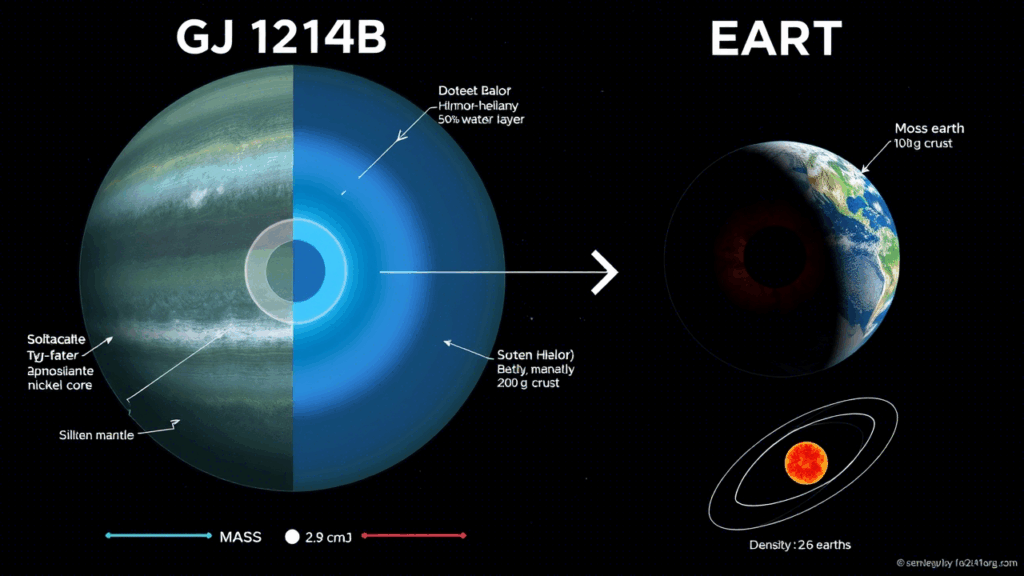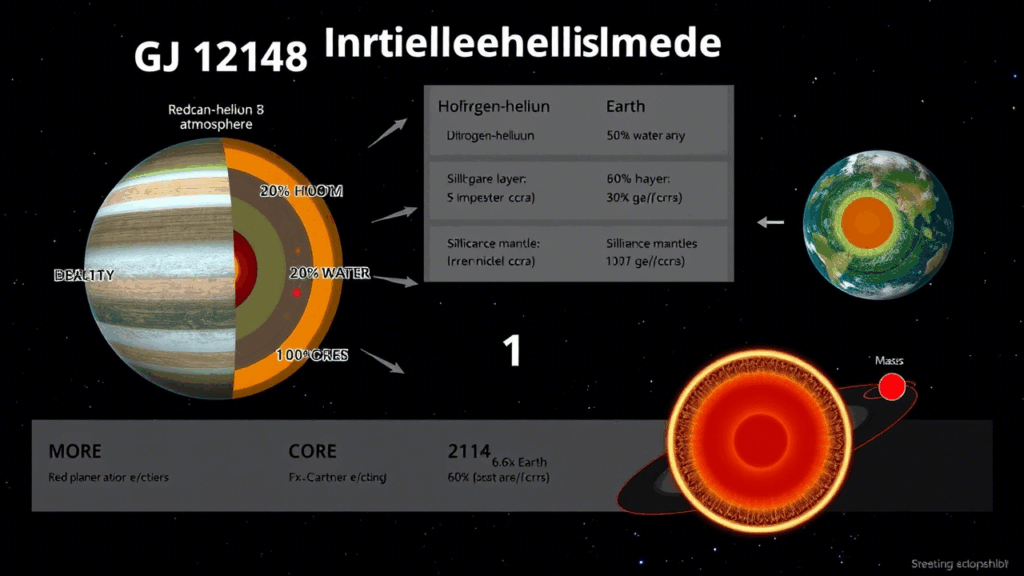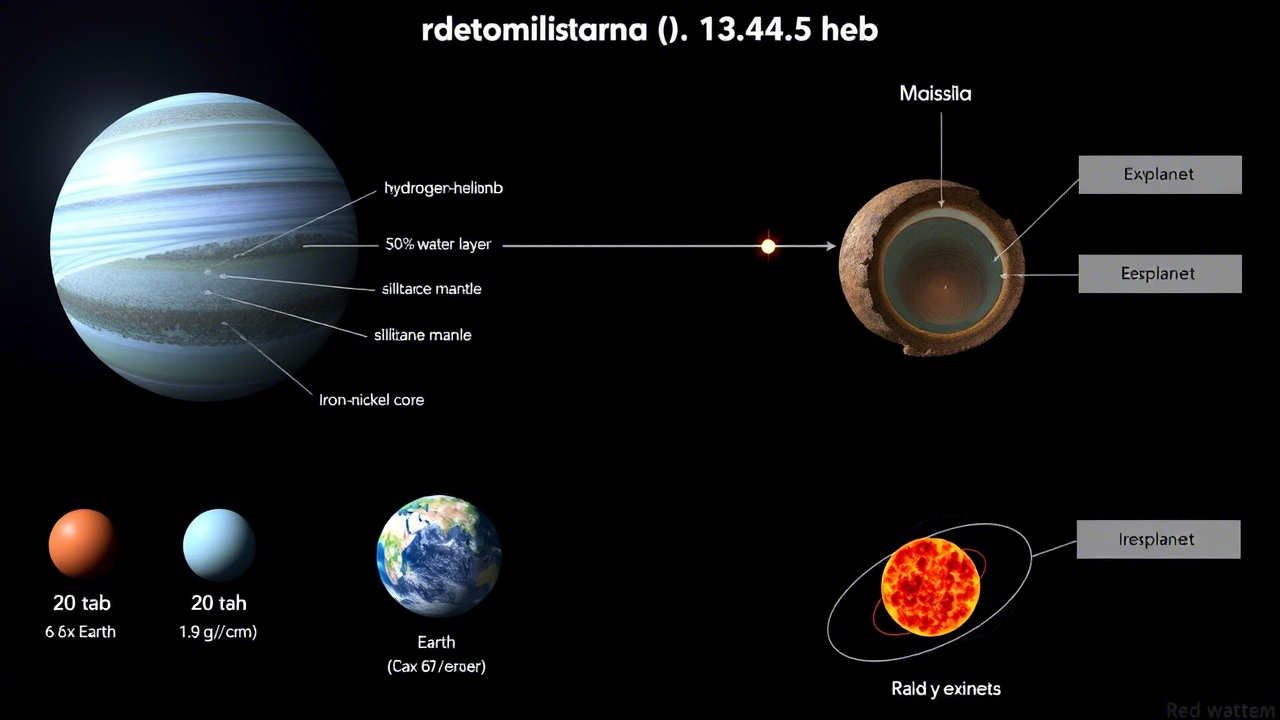What is GJ 1214b?
GJ 1214b is not your average exoplanet. It’s massive, mysterious, and nothing like what we see in our solar system. This sub-Neptune-sized world orbits a small red dwarf star around 48 light-years away in the constellation Ophiuchus. Its official discovery happened in 2009, and ever since, it has become one of the most intensely studied exoplanets in modern astronomy. But what makes it so fascinating?
How Big Is GJ 1214b and Why Does It Matter?
GJ 1214b has a radius about 2.7 times that of Earth and a mass around 8.2 times greater. That places it in a rare category too large to be a rocky planet like Earth, but too small to be a gas giant like Neptune. This kind of planet doesn’t exist in our solar system, which is why astronomers call it a “sub-Neptune” or “mini-Neptune.” Understanding planets in this size range helps scientists fill the gaps in our knowledge about how planets form and evolve. It’s also one reason why GJ 1214b draws so much attention.
Why Is Its Orbit So Extreme?
Orbiting its star every 1.58 Earth days, GJ 1214b is incredibly close to its host star. This proximity exposes it to intense heat, making its equilibrium temperature far higher than anything Earth experiences. Such conditions are extreme and likely prevent the planet from being habitable. But even without habitability, GJ 1214b has plenty to teach us.

What’s in Its Atmosphere?
For a long time, the atmosphere of GJ 1214b was an enigma. Early telescopes caught only glimpses of thick haze, making it hard to determine its composition. Then, the James Webb Space Telescope changed the game. With data from JWST, scientists now believe the atmosphere is mostly made of carbon dioxide, not hydrogen, as they previously thought. Some methane might also be present, and there’s a surprising amount of metallicity, meaning it contains elements heavier than hydrogen and helium.
Could It Be a Water World?
That was the original theory. Astronomers thought GJ 1214b might be covered in a deep global ocean with a thick, steamy atmosphere. But newer data doesn’t support this. JWST found no strong signals indicating water vapor in the atmosphere. Instead, the dominant presence of carbon dioxide suggests a different kind of planet entirely—one that may be more similar to Venus in terms of atmospheric chemistry but still very distinct.
Is It a Super-Venus?
Yes and no. The term “super-Venus” gets tossed around because GJ 1214b’s atmosphere is so rich in carbon dioxide, just like Venus. However, its formation history, internal structure, and location in its solar system are likely different from Venus’s story. This planet may not fit cleanly into any existing category. Some researchers even propose that it represents a new class of exoplanet entirely.
What Makes Studying GJ 1214b So Important?
There are several reasons. First, sub-Neptune-sized planets are incredibly common across the galaxy. By learning more about GJ 1214b, scientists can better understand a broad class of planets that we don’t see in our backyard. Second, its carbon-rich atmosphere challenges the traditional models that scientists use to predict planet formation. This forces researchers to think differently and refine their theories. Third, the planet’s dense haze layer has pushed the boundaries of how we observe distant atmospheres. In trying to understand this one planet, we’ve developed tools and methods that will help unlock the mysteries of many others.

Could There Be Geological Activity?
It’s possible. A carbon dioxide-rich atmosphere might indicate active volcanism releasing gases into the atmosphere over time. This idea is still under investigation, but it adds another layer of complexity to how GJ 1214b operates. Volcanic activity on such a hot, dense planet could mean its surface and interior are far more dynamic than we imagined.
Does GJ 1214b Have Any Eco-Friendly Implications?
While the planet itself is far from eco-friendly—its toxic atmosphere and extreme heat make it inhospitable—its study has indirect environmental benefits. The technologies developed to analyze its atmosphere are now being applied to study Earth’s climate systems. In that sense, learning about exoplanets like GJ 1214b can inform better eco-friendly solutions here on Earth, especially in areas like climate modeling and atmospheric monitoring.
Is It a Glimpse into the Future of Exoplanet Research?
Absolutely. GJ 1214b demonstrates just how powerful modern telescopes like JWST have become. The clarity with which scientists can now observe atmospheres across light-years opens up possibilities to study many more planets in detail. This enhances our ability to assess which ones might host life, which ones resemble Earth, and which, like GJ 1214b, defy our expectations entirely.
What Are We Learning from JWST’s Observations?
JWST has reshaped our understanding of GJ 1214b. Its precise measurements revealed the planet’s thick carbon dioxide clouds, high metallicity, and lack of water vapor. These findings contradict earlier theories and suggest a new kind of planet altogether. JWST’s role in this discovery underscores the telescope’s capacity to unlock secrets that were once buried under layers of cosmic haze.
Also Read:https://globaltrek.co.uk/alberg-37-for-sale/
Final Thoughts: Is GJ 1214b Just the Beginning?
GJ 1214b may be one planet, but its lessons ripple through the entire field of astronomy. It challenges old models, refines observational tools, and introduces the possibility of entirely new planetary types. As a case study, it’s invaluable. As a world, it’s unlike any we’ve ever known.
Studying planets like GJ 1214b isn’t just about space—it’s about understanding the rules that govern the cosmos. With every new detail we uncover, we move closer to answering fundamental questions about where we come from and what kinds of worlds exist beyond our own.
Bottom Line: Understand it. Manage it. Don’t fear it. Let GJ 1214b teach us how to explore wisely—and maybe even help make our own world more eco friendly.



